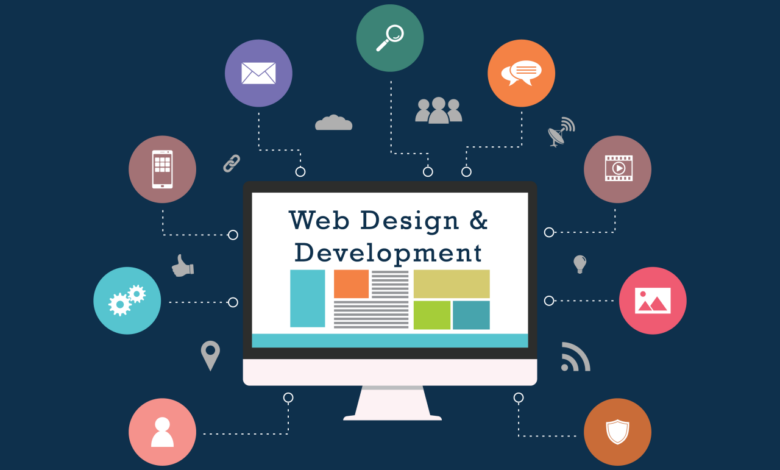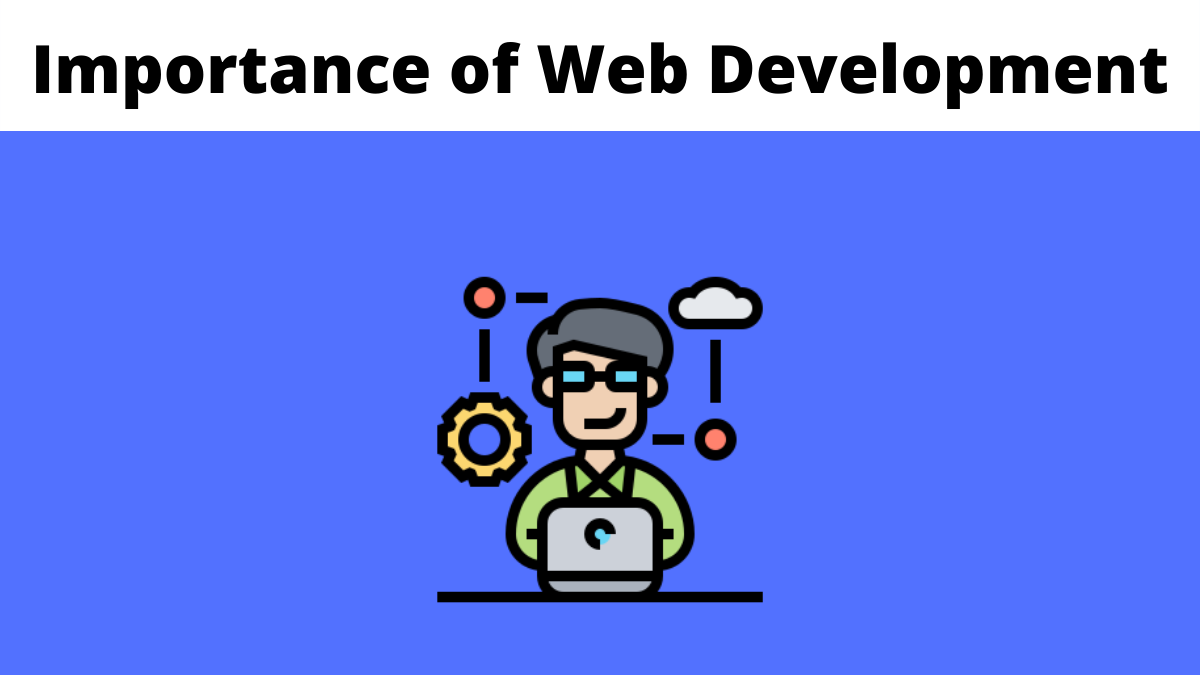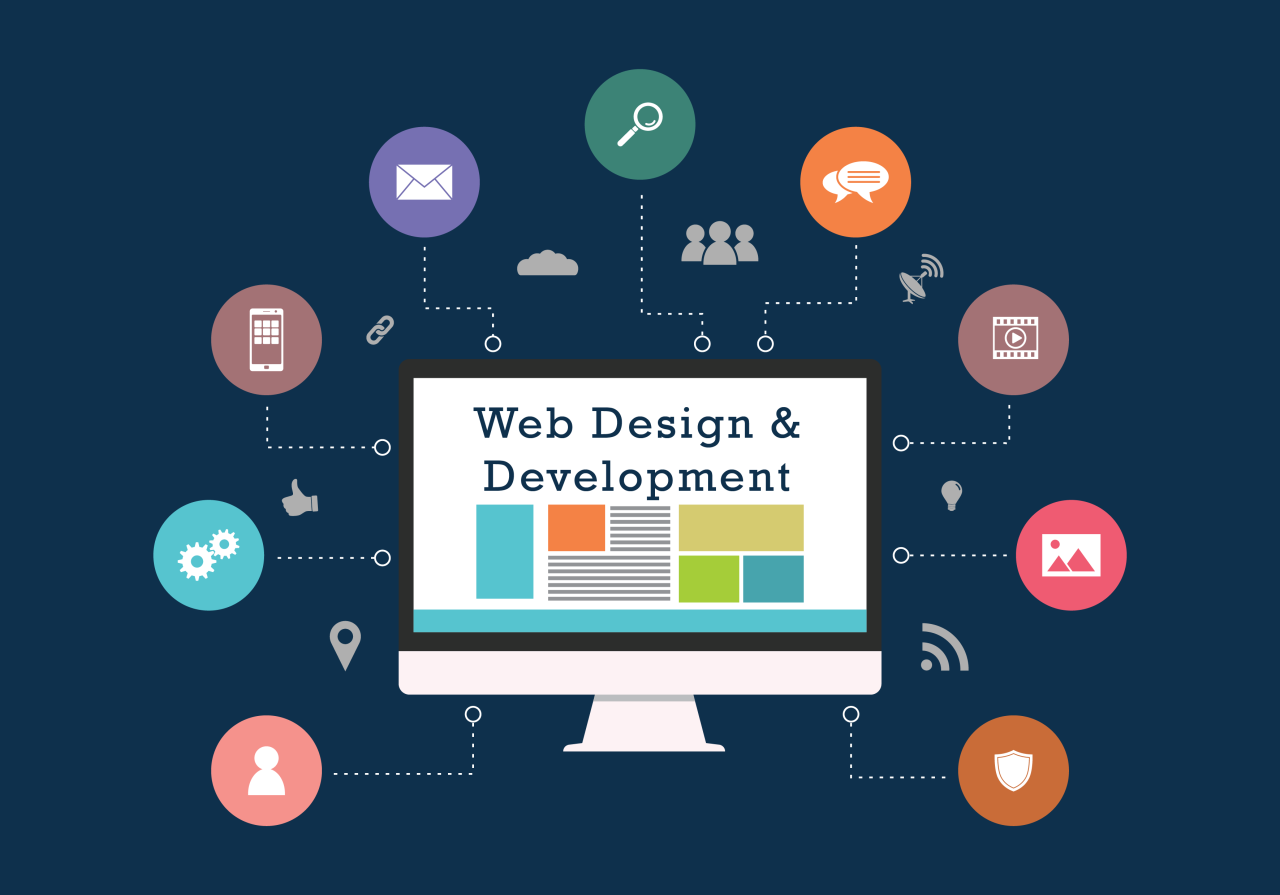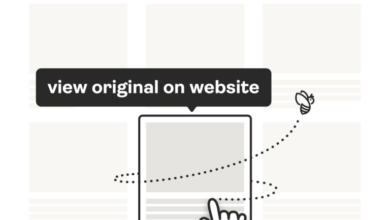
The Importance of Web Development
The importance of web development is undeniable in today’s digital world. From small businesses vying for online visibility to global corporations shaping online experiences, the web has become the central hub for communication, commerce, and connection. This post dives deep into why web development matters, exploring its historical evolution, current trends, and the crucial role it plays in shaping our world.
We’ll unpack the essential skills and technologies driving innovation, examining the impact of web development on society, and considering the ethical implications of this ever-evolving field. We’ll also look towards the future, exploring emerging technologies and their potential to revolutionize the way we interact with the digital landscape. Get ready to discover why understanding web development is no longer optional—it’s essential.
The Ever-Evolving Landscape of Web Development: The Importance Of Web Development
Web development, the art and science of crafting online experiences, has undergone a dramatic transformation since its inception. From simple static pages to the dynamic, interactive applications we see today, the field has consistently pushed technological boundaries, driven by user demands and innovative solutions. This evolution continues at a breakneck pace, making it a fascinating and perpetually challenging domain.
Historical Evolution of Web Development Technologies
The early days of the web (roughly 1990-2000) were dominated by static HTML pages. Information was presented linearly, with limited interactivity. The introduction of Cascading Style Sheets (CSS) in 1996 allowed for improved visual presentation and separation of content from style. JavaScript, first appearing in 1995, added a layer of dynamic behavior, although its capabilities were initially quite limited.
The rise of server-side scripting languages like PHP, ASP, and Perl enabled the creation of dynamic websites, allowing for user-specific content and database interaction. This period laid the foundation for the web as we know it, establishing core concepts that still underpin modern development. The early 2000s saw the rise of AJAX, which improved the user experience by enabling asynchronous updates without full page reloads.
Current Trends and Future Predictions in Web Development
Currently, the web development landscape is characterized by several key trends. The increasing adoption of frameworks and libraries like React, Angular, and Vue.js simplifies front-end development, enabling the creation of complex user interfaces efficiently. On the back-end, Node.js and frameworks like Express.js have gained popularity, providing efficient and scalable solutions. Progressive Web Apps (PWAs) are bridging the gap between web and mobile applications, offering enhanced user experiences with offline capabilities and push notifications.
The growing importance of security is also evident, with practices like secure coding and authentication becoming paramount. Looking ahead, we can anticipate further advancements in artificial intelligence (AI) integration, enhancing personalization and automation in web applications. The metaverse and Web3 technologies are also poised to significantly influence the future of web development, leading to more immersive and interactive online experiences.
For example, the integration of AI-powered chatbots is already transforming customer service interactions on many websites.
Comparison of Web Development Approaches
Front-end development focuses on the user interface (UI) and user experience (UX) aspects of a website. Developers use HTML, CSS, and JavaScript to create visually appealing and interactive interfaces. Back-end development, on the other hand, deals with the server-side logic, databases, and APIs. Languages like Python, Java, PHP, Ruby, and Node.js are commonly used for back-end development.
Static websites have content that remains constant unless manually updated, while dynamic websites utilize server-side scripting to generate content based on user input or other factors. For example, a blog with fixed content is static, whereas an e-commerce site with user accounts and dynamic product displays is dynamic.
Timeline of Key Advancements in Web Development
| Year | Technology | Description |
|---|---|---|
| 1989 | Tim Berners-Lee proposes the World Wide Web | The foundational concept of the web is conceived. |
| 1991 | First website goes live | The world’s first website, at CERN, marks the beginning of the web’s public presence. |
| 1995 | JavaScript released | Introduces client-side scripting capabilities. |
| 1996 | CSS introduced | Allows for separation of content and style in web pages. |
| 2005 | AJAX becomes prominent | Enables asynchronous updates, improving user experience. |
| 2009 | Node.js released | Provides a JavaScript runtime environment for server-side development. |
| 2010s – Present | Rise of JavaScript Frameworks (React, Angular, Vue.js) | Simplify front-end development and improve efficiency. |
The Role of Web Development in Business and Commerce
In today’s digital age, a strong online presence is no longer a luxury but a necessity for businesses of all sizes. Web development plays a pivotal role in establishing and maintaining this crucial online footprint, directly impacting a company’s ability to connect with customers, build brand awareness, and ultimately, drive revenue. A well-designed and functional website acts as a virtual storefront, a communication hub, and a marketing engine, all rolled into one.Web development significantly contributes to improved customer engagement and brand building.
A user-friendly website with intuitive navigation and compelling content keeps visitors engaged and encourages them to explore further. Consistent branding across the website, including logo, color scheme, and messaging, reinforces brand identity and fosters recognition. This cohesive online presence helps build trust and loyalty, turning casual visitors into repeat customers and brand advocates.
Increased Sales and Revenue Through Web Development
Businesses leverage web development in various ways to boost sales and revenue. E-commerce platforms, powered by sophisticated web development, allow businesses to sell products and services directly to consumers online. This expands market reach beyond geographical limitations and provides 24/7 accessibility. Furthermore, targeted online advertising campaigns, often managed through website analytics and marketing automation tools, can effectively reach potential customers and drive traffic to the website, leading to increased sales conversions.
Lead generation forms, integrated seamlessly into websites, capture valuable customer information, allowing businesses to nurture leads and convert them into paying customers. Finally, optimized websites that rank highly in search engine results pages (SERPs) attract organic traffic, driving more potential customers to the business without incurring advertising costs.
Case Study: “Artisan Coffee Roasters”
Imagine “Artisan Coffee Roasters,” a small, family-owned coffee shop with a loyal local following. Initially, their online presence was limited to a simple Facebook page. Their sales were restricted to their physical location, limiting their growth potential. After investing in professional web development, they launched a website featuring high-quality images of their coffee beans and brewing process, a blog highlighting their commitment to sustainability and ethical sourcing, and an online store for ordering beans and merchandise.
They also integrated online ordering and local delivery options. Within six months, their online sales increased by 40%, attracting new customers from neighboring towns and cities. The website also served as a platform for building their brand story, reinforcing their commitment to quality and community, leading to increased customer loyalty and positive word-of-mouth referrals. Their improved online presence transformed them from a local favorite into a regional brand, significantly impacting their revenue and overall business growth.
Essential Skills and Technologies in Web Development

Source: mexseo.info
The ever-evolving world of web development demands a diverse skill set, encompassing both technical proficiency and soft skills. Mastering the right technologies and cultivating strong collaborative abilities are key to building a successful and rewarding career in this dynamic field. This section delves into the core skills and technologies that form the bedrock of modern web development.
Core Programming Languages and Frameworks
Modern web development relies on a combination of front-end and back-end technologies. Front-end development focuses on the user interface and user experience (UI/UX), while back-end development handles server-side logic, databases, and APIs. Proficiency in several key languages and frameworks is essential for building robust and scalable web applications. For front-end development, HTML, CSS, and JavaScript are fundamental.
Popular JavaScript frameworks include React, Angular, and Vue.js, each offering unique strengths and approaches to building interactive user interfaces. On the back-end, languages like Python, Java, PHP, Node.js (JavaScript), Ruby, and Go are commonly used, often in conjunction with frameworks such as Django (Python), Spring Boot (Java), Laravel (PHP), Express.js (Node.js), Ruby on Rails (Ruby), and Gin (Go). The choice of language and framework often depends on project requirements, team expertise, and scalability needs.
For example, React’s component-based architecture makes it well-suited for large, complex applications, while Vue.js’s ease of learning makes it ideal for smaller projects or rapid prototyping.
Essential Soft Skills for Web Developers
Technical skills are only half the battle. Successful web developers also possess a strong set of soft skills that enable effective collaboration, problem-solving, and continuous learning. These include:
- Communication: Clearly articulating technical concepts to both technical and non-technical audiences is crucial.
- Problem-solving: Debugging code and finding creative solutions to complex challenges is a daily occurrence.
- Teamwork: Web development is often a collaborative effort, requiring effective communication and coordination with designers, other developers, and project managers.
- Time management: Meeting deadlines and managing multiple projects simultaneously are essential skills.
- Adaptability: The web development landscape is constantly evolving, so the ability to learn new technologies and adapt to change is critical.
Comparison of Popular Front-End and Back-End Frameworks
Choosing the right framework is crucial for project success. Here’s a comparison of some popular options:
| Framework | Type | Strengths | Weaknesses |
|---|---|---|---|
| React | Front-end | Large community, component-based architecture, virtual DOM for performance, JSX for templating | Steeper learning curve than some alternatives, can be verbose |
| Angular | Front-end | Comprehensive framework, built-in features for routing, state management, and testing, TypeScript support | Can be complex for smaller projects, larger bundle size |
| Vue.js | Front-end | Easy to learn, progressive adoption, excellent documentation, performant | Smaller community compared to React and Angular, fewer readily available third-party libraries |
| Node.js (with Express.js) | Back-end | JavaScript everywhere (full-stack JavaScript), non-blocking I/O for scalability, large community | Can be challenging for complex applications, requires careful handling of asynchronous operations |
| Django | Back-end | Pythonic, batteries-included framework, robust ORM, strong security features | Can feel opinionated for some developers, steeper learning curve than some alternatives |
| Laravel | Back-end | Elegant syntax, robust features for routing, templating, and database interaction, large community | Can be resource-intensive for very large applications |
Building a Simple Web Page with HTML, CSS, and JavaScript, The importance of web development
Let’s illustrate the basics by creating a simple web page. First, we use HTML to structure the content:
This is a simple paragraph.
Next, we style the page using CSS (in `styles.css`): h1 color: blue; text-align: center;p font-size: 16px;Finally, we add some interactivity with JavaScript (in `script.js`): alert("Welcome to my web page!");This simple example demonstrates the fundamental roles of HTML for structure, CSS for styling, and JavaScript for adding dynamic behavior. More complex web applications build upon these foundational elements, incorporating more advanced techniques and frameworks.
The Impact of Web Development on Society and Culture

Source: amazingelearning.com
Web development has fundamentally reshaped how we interact, learn, and experience the world. Its impact extends far beyond the digital realm, profoundly influencing societal structures, cultural norms, and the very fabric of our daily lives. This pervasive influence necessitates a careful examination of both its positive and negative consequences.
Global Communication and Collaboration
The internet, a product of web development, has dramatically shrunk the world. Instantaneous communication across geographical boundaries allows for real-time collaboration on projects, fostering international understanding and the sharing of ideas and cultures. Businesses operate globally, individuals connect with family and friends across continents, and collaborative projects involving researchers and artists from different nations become readily achievable. This interconnectedness has facilitated the rise of global communities built around shared interests, promoting cultural exchange and understanding in ways unimaginable just a few decades ago.
For example, open-source software projects rely heavily on global collaboration, with developers from various countries contributing code and expertise.
The Influence of Web Development on Education and Access to Information
Web development has revolutionized education and access to information. Online learning platforms provide educational resources to individuals worldwide, regardless of their geographical location or socioeconomic background. Massive Open Online Courses (MOOCs) offer university-level education at a fraction of the cost of traditional institutions. Digital libraries and online archives make vast quantities of information readily accessible, empowering individuals to pursue knowledge independently.
However, this increased access also presents challenges, including the need for digital literacy and critical evaluation of online information to combat misinformation and biased sources. The democratization of information, while largely positive, requires a parallel effort to promote media literacy and critical thinking skills.
Examples of Web Development’s Societal Impact
Web development has had a multifaceted impact on society, exhibiting both positive and negative aspects. Positively, e-commerce has revolutionized retail, offering consumers greater choice and convenience. Social media platforms connect individuals globally, fostering communities and enabling social movements. However, the same social media platforms can also be breeding grounds for misinformation, hate speech, and cyberbullying. The rise of online surveillance raises significant privacy concerns, while the digital divide continues to exacerbate inequalities in access to technology and information.
The development of sophisticated AI algorithms raises ethical dilemmas regarding bias, job displacement, and the potential for misuse. The impact of web development is therefore complex and requires careful consideration of its ethical implications.
Ethical Considerations in Web Development and Design
The power of web development necessitates a strong ethical framework. Consideration should be given to:
- Privacy and Data Security: Protecting user data and ensuring transparency in data collection practices are paramount.
- Accessibility: Designing websites and applications that are accessible to individuals with disabilities is crucial for inclusivity.
- Bias and Fairness: Algorithms and AI systems should be designed and implemented to avoid perpetuating existing societal biases.
- Transparency and Accountability: Clear communication about data usage and algorithms is essential for building trust.
- Digital Divide: Efforts should be made to bridge the digital divide and ensure equitable access to technology and information.
- Environmental Impact: The energy consumption of data centers and the environmental impact of electronic waste should be considered.
Web Development and Accessibility
Building websites that are accessible to everyone, regardless of ability, is not just a matter of good ethics; it’s a legal and business imperative. An accessible website expands your potential audience significantly, ensuring that people with disabilities can navigate and interact with your online content with ease. Ignoring accessibility means excluding a large and valuable segment of the population.Accessibility in web development focuses on creating user experiences that are usable by people with a wide range of disabilities, including visual, auditory, motor, and cognitive impairments.
This involves adhering to established guidelines and best practices to ensure that information is presented in a clear, consistent, and understandable manner. The benefits extend beyond simply complying with regulations; accessible design often improves the user experience for everyone.
Accessibility Standards and Guidelines
Web Content Accessibility Guidelines (WCAG) are the most widely recognized and respected set of guidelines for creating accessible web content. These guidelines are developed by the World Wide Web Consortium (W3C) and provide a comprehensive framework for making websites accessible to people with disabilities. WCAG 2.1, the current version, organizes accessibility requirements into four principles: Perceivable, Operable, Understandable, and Robust.
These principles are further broken down into success criteria, each with specific testable guidelines. For instance, providing alternative text for images (Perceivable) ensures that screen readers can convey the image’s content to visually impaired users. Using keyboard navigation (Operable) allows users with motor impairments to interact with the website without a mouse. Clear and concise language (Understandable) makes the website easier to comprehend for everyone, including those with cognitive disabilities.
Finally, ensuring compatibility with assistive technologies (Robust) guarantees that the website functions correctly with screen readers, speech recognition software, and other tools.
Best Practices for Accessible Web Experiences
Several best practices contribute to creating inclusive and user-friendly websites. Using semantic HTML is crucial for structuring content logically and providing context for assistive technologies. For example, using headings (
to
) correctly structures the page, allowing screen reader users to navigate the content efficiently. Providing clear and concise text, avoiding jargon and complex sentence structures, improves comprehension for all users. Sufficient color contrast between text and background is essential for users with low vision, and alt text for images is crucial for screen reader users to understand the image’s context. Furthermore, ensuring keyboard navigation allows users with motor impairments to fully interact with the website. Captions and transcripts for videos and audio content make multimedia accessible to deaf and hard-of-hearing individuals. Interactive elements should be clearly labeled and easy to use, with sufficient time limits for completing tasks. Form fields should be clearly labeled and provide instructions where needed. Finally, using ARIA attributes can enhance the accessibility of complex interactive elements.
Incorporating Accessibility Features into the Development Lifecycle
Incorporating Accessibility Features into the Development Lifecycle
The following flowchart illustrates a systematic approach to incorporating accessibility features throughout the web development process.[Imagine a flowchart here. The flowchart would start with “Project Initiation,” branching to “Accessibility Planning” (defining accessibility goals and choosing appropriate technologies), then “Design and Development” (implementing accessibility features according to WCAG guidelines), followed by “Testing and Evaluation” (using automated tools and manual testing to identify and fix accessibility issues), and finally “Deployment and Maintenance” (ensuring ongoing accessibility).]The flowchart depicts the iterative nature of accessibility implementation.
Each stage requires careful planning and execution to ensure a fully accessible website. Regular testing and evaluation are critical throughout the process to identify and address any accessibility issues that may arise.
The Future of Web Development
The world of web development is constantly evolving, driven by rapid advancements in technology. What was cutting-edge just a few years ago is now commonplace, and the pace of innovation shows no signs of slowing. Understanding the emerging technologies shaping the future of web development is crucial for anyone involved in this dynamic field, whether as a developer, designer, or business owner.
This exploration will delve into some of the most impactful technologies poised to revolutionize how we build and experience the web.
Artificial Intelligence and Machine Learning in Web Development
AI and ML are no longer futuristic concepts; they are actively reshaping web development. AI-powered tools are improving efficiency in various stages of development, from code generation and debugging to personalized user experiences. Machine learning algorithms analyze user data to anticipate needs and preferences, leading to more intuitive and effective websites and applications. For example, Netflix utilizes ML to recommend shows and movies based on viewing history, drastically improving user engagement.
This technology also powers sophisticated chatbots that provide instant customer support, reducing the workload on human agents and improving response times. The integration of AI and ML will continue to streamline workflows and enhance the overall user experience.
Virtual and Augmented Reality in Web Experiences
VR and AR are transforming how users interact with digital content. VR offers immersive, 360-degree experiences, allowing users to explore virtual environments as if they were physically present. AR overlays digital information onto the real world, enhancing user perception and interaction. Imagine trying on clothes virtually using AR before purchasing them online, or taking a virtual tour of a property using VR before visiting it in person.
These technologies are no longer confined to gaming; they’re finding applications in e-commerce, education, and even healthcare, creating more engaging and interactive web experiences. The development of web applications that seamlessly integrate VR and AR will be a key focus in the coming years.
Emerging Technologies Revolutionizing Web Development
Beyond AI, ML, VR, and AR, several other technologies are poised to significantly impact web development. The rise of WebAssembly, a binary instruction format, allows for faster and more efficient execution of code in web browsers, paving the way for more complex and resource-intensive applications. Blockchain technology, known for its secure and transparent data management, is finding applications in decentralized web applications (dApps) and secure data storage.
Solid web development skills are crucial in today’s digital landscape; a strong online presence is essential for success. Want to boost your visibility? Check out this awesome guide on getting it on with YouTube to learn how to leverage video marketing. Ultimately, though, a well-designed website remains the cornerstone of any effective online strategy, providing a central hub for all your content and branding.
Progressive Web Apps (PWAs) are bridging the gap between web and mobile applications, offering users a native app-like experience without the need for downloads. The convergence of these technologies promises a future web that is faster, more secure, and more accessible than ever before.
A Futuristic Web Experience
Imagine a future where you put on a pair of AR glasses and walk into your living room. Your smart home system, powered by AI, recognizes you and projects a holographic interface onto your coffee table. You use voice commands to browse a 3D model of a new car using VR, exploring its features in detail. The entire experience is seamless and intuitive, powered by a fast and secure WebAssembly-based application, and your data is protected by blockchain technology.
This is not science fiction; it’s a glimpse into the potential of emerging technologies to transform how we interact with the web in the years to come.
Final Thoughts

Source: greatlike.com
In short, the importance of web development transcends simple website creation; it’s about building connections, fostering innovation, and shaping the future. From its humble beginnings to its current complex state, web development continues to evolve, offering endless opportunities for creativity, problem-solving, and impact. Whether you’re a business owner, a student, or simply curious about the digital world, understanding the power of web development is key to navigating our increasingly interconnected future.
FAQs
What’s the difference between front-end and back-end development?
Front-end development focuses on the user interface (what you see and interact with), using HTML, CSS, and JavaScript. Back-end development handles the server-side logic and databases, powering the functionality behind the scenes.
How much does it cost to hire a web developer?
The cost varies greatly depending on experience, location, and project scope. Expect to pay anywhere from a few hundred to several thousand dollars or more.
Is web development a good career path?
Absolutely! The demand for skilled web developers is high and consistently growing, offering excellent job prospects and competitive salaries.
Can I learn web development on my own?
Yes! Numerous online resources, courses, and tutorials are available to help you learn at your own pace. However, structured learning through a bootcamp or degree program can be beneficial.





